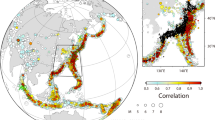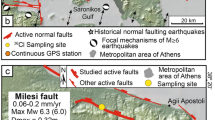Abstract
In the subduction zones around Japan, where four plates interact with one another, large earthquakes have occurred repeatedly1. These interplate earthquakes are part of the process of tectonic stress accumulation and release that is driven by relative plate motion2,3,4. Stress accumulation between earthquakes results from slip deficit (slip that is insufficient to fully accommodate plate movement). For the prediction of large earthquakes, it is therefore important to monitor the distribution of slip deficit on plate interfaces. Here we apply an inversion method based on Bayesian modelling (using direct and indirect prior information on the magnitude and distribution of fault slip5) to horizontal and vertical velocities from global positioning system data. For the seismically calm period between 1996 and 2000, we obtain a precise distribution of slip-deficit rates on the interface between the North American and Pacific plates around Japan, which reveals a trench-parallel belt of slip deficit with six peaks in the depth range of 10–40 km. These peaks agree with the source regions of past large interplate earthquakes along the Kuril–Japan trench. We conclude that the slip-deficit zones identified with our method are potential source regions of large earthquakes.
This is a preview of subscription content, access via your institution
Access options
Subscribe to this journal
Receive 12 print issues and online access
$259.00 per year
only $21.58 per issue
Buy this article
- Purchase on Springer Link
- Instant access to full article PDF
Prices may be subject to local taxes which are calculated during checkout




Similar content being viewed by others
References
Utsu, T. Seismicity Studies: A Comprehensive Review [in Japanese] (Univ. of Tokyo Press, 1999).
Hashimoto, C. & Matsu’ura, M. 3-D physical modelling of stress accumulation and release processes at transcurrent plate boundaries. Pure Appl. Geophys. 157, 2125–2147 (2000).
Hashimoto, C. & Matsu’ura, M. 3-D simulation of earthquake generation cycles and evolution of fault constitutive properties. Pure Appl. Geophys. 159, 2175–2199 (2002).
Fukuyama, E., Hashimoto, C. & Matsu’ura, M. Simulation of the transition of earthquake rupture from quasi-static growth to dynamic propagation. Pure Appl. Geophys. 159, 2057–2066 (2002).
Matsu’ura, M., Noda, A. & Fukahata, Y. Geodetic data inversion based on Bayesian formulation with direct and indirect prior information. Geophys. J. Int. 171, 1342–1351 (2007).
Matsu’ura, M. Quest for predictability of geodynamic processes through computer simulation. Comput. Sci. Eng. 7, 43–50 (2005).
Sagiya, T., Miyazaki, S. & Tada, T. Continuous GPS array and present-day crustal deformation of Japan. Pure Appl. Geophys. 157, 2303–2322 (2000).
Ito, T., Yoshioka, S. & Miyazaki, S. Interplate coupling in northeast Japan deduced from inversion analysis of GPS data. Earth Planet. Sci. Lett. 176, 117–130 (2000).
Mazzotti, S., Le Pichon, X. & Henry, P. Full interseismic locking of the Nankai and Japan-west Kurile subduction zones: An analysis of uniform elastic strain accumulation in Japan constrained by permanent GPS. J. Geophys. Res. 105, 13159–13177 (2000).
Nishimura, T. et al. Temporal change of interplate coupling in northeast Japan during 1995-2002 estimated from continuous GPS observations. Geophys. J. Int. 57, 901–916 (2004).
Suwa, Y., Miura, S., Hasegawa, A., Sato, T. & Tachibana, K. Interplate coupling beneath NE Japan inferred from three-dimensional displacement field. J. Geophys. Res. 111, B04402 (2006).
Akaike, H. in Application of Statistics (ed. Krishnaiah, P. R.) 27–41 (North-Holland, 1977).
Akaike, H. in Bayesian Statistics (eds Bernardo, J. M., DeGroot, M. H., Lindley, D. V. & Smith, A. F. M.) 143–166 (Valencia Univ. Press, 1980).
Jackson, D. D. & Matsu’ura, M. A Bayesian approach to nonlinear inversion. J. Geophys. Res. 90, 581–591 (1985).
Yabuki, T. & Matsu’ura, M. Geodetic data inversion using a Bayesian information criterion for spatial distribution of fault slip. Geophys. J. Int. 109, 363–375 (1992).
Matsu’ura, M. & Sato, T. A dislocation model for the earthquake cycle at convergent plate boundaries. Geophys. J. Int. 96, 23–32 (1989).
Hashimoto, C., Fukui, K. & Matsu’ura, M. 3-D modelling of plate interfaces and numerical simulation of long-term crustal deformation in and around Japan. Pure Appl. Geophys. 161, 2053–2068 (2004).
DeMets, C., Gordon, R. G., Argus, D. F. & Stein, S. Effect of recent revisions to the geomagnetic reversal timescale on estimates of current plate motions. Geophys. Res. Lett. 21, 2191–2194 (1994).
Hatri, T. Reexamination of the wave source of the 1952 Tokacji-oki tsunami [in Japanese with English abstract]. J. Seismol. Soc. Jpn. 26, 206–208 (1973).
Hatri, T. Tsunami sources on the Pacific side in northeast Japan [in Japanese with English abstract]. J. Seismol. Soc. Jpn. 27, 321–337 (1974).
Hatri, T. Tsunami activity in eastern Hokkaido after the off Nemuro peninsula earthquake in 1973 [in Japanese with English abstract]. J. Seismol. Soc. Jpn. 28, 461–471 (1975).
Hatri, T. The 1994 Sanriku-oki tsunami and distribution of the radiating tsunami energy in the Sanriku region [in Japanese with English abstract]. J. Seismol. Soc. Jpn. 49, 19–26 (1996).
Yamanaka, Y. & Kikuchi, M. Asperity map along the subduction zone in northeastern Japan inferred from regional seismic data. J. Geophys. Res. 109, B07307 (2004).
Yagi, Y. Source rupture process of the 2003 Tokachi-oki earthquake determined by joint inversion of teleseismic body wave and strong ground motion data. Earth Planets Space 56, 311–316 (2004).
Hirata, K., Tanioka, Y., Satake, K., Yamaki, S. & Geist, E. L. The tsunami source area of the 2003 Tokachi-oki earthquake estimated from tsunami travel times and its relationship to the 1952 Tokachi-oki earthquake. Earth Planets Space 56, 367–372 (2004).
Nanayama, F. et al. Unusually large earthquakes inferred from tsunami deposits along the Kuril trench. Nature 424, 660–663 (2003).
Acknowledgements
We thank Roland Bürgmann for his useful suggestion to improve the manuscript. Computation of viscoelastic slip-response functions was carried out on the Earth Simulator at the Earth Simulator Center, Japan Agency for Marine-Earth Science and Technology (JAMSTEC).
Author information
Authors and Affiliations
Corresponding author
Supplementary information
Supplementary Information, Table S1
Supplementary Information (PDF 1383 kb)
Rights and permissions
About this article
Cite this article
Hashimoto, C., Noda, A., Sagiya, T. et al. Interplate seismogenic zones along the Kuril–Japan trench inferred from GPS data inversion. Nature Geosci 2, 141–144 (2009). https://doi.org/10.1038/ngeo421
Received:
Accepted:
Published:
Issue Date:
DOI: https://doi.org/10.1038/ngeo421
This article is cited by
-
Progress in modeling the Tohoku-oki megathrust earthquake cycle and associated crustal deformation processes
Progress in Earth and Planetary Science (2023)
-
Joint inversion of ocean-bottom pressure and GNSS data from the 2003 Tokachi-oki earthquake
Earth, Planets and Space (2023)
-
A review on slow earthquakes in the Japan Trench
Progress in Earth and Planetary Science (2023)
-
A new mechanical perspective on a shallow megathrust near-trench slip from the high-resolution fault model of the 2011 Tohoku-Oki earthquake
Progress in Earth and Planetary Science (2022)
-
Focal mechanisms and the stress field in the aftershock area of the 2018 Hokkaido Eastern Iburi earthquake (MJMA = 6.7)
Earth, Planets and Space (2021)



